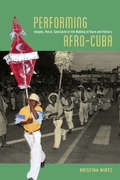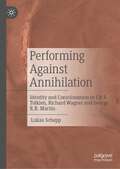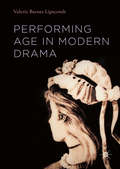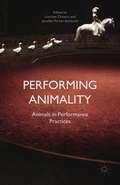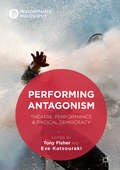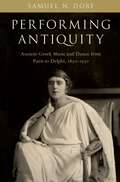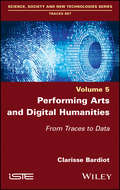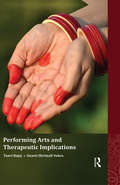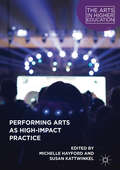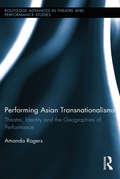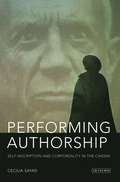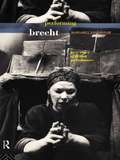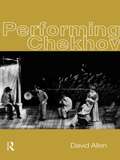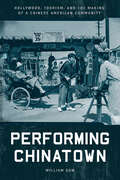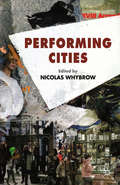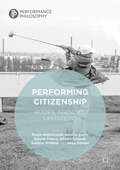- Table View
- List View
Performing Afro-Cuba: Image, Voice, Spectacle in the Making of Race and History
by Kristina WirtzVisitors to Cuba will notice that Afro-Cuban figures and references are everywhere: in popular music and folklore shows, paintings and dolls of Santería saints in airport shops, and even restaurants with plantation themes. In Performing Afro-Cuba, Kristina Wirtz examines how the animation of Cuba’s colonial past and African heritage through such figures and performances not only reflects but also shapes the Cuban experience of Blackness. She also investigates how this process operates at different spatial and temporal scales—from the immediate present to the imagined past, from the barrio to the socialist state. Wirtz analyzes a variety of performances and the ways they construct Cuban racial and historical imaginations. She offers a sophisticated view of performance as enacting diverse revolutionary ideals, religious notions, and racial identity politics, and she outlines how these concepts play out in the ongoing institutionalization of folklore as an official, even state-sponsored, category. Employing Bakhtin’s concept of “chronotopes”—the semiotic construction of space-time—she examines the roles of voice, temporality, embodiment, imagery, and memory in the racializing process. The result is a deftly balanced study that marries racial studies, performance studies, anthropology, and semiotics to explore the nature of race as a cultural sign, one that is always in process, always shifting.
Performing Afro-Cuba: Image, Voice, Spectacle in the Making of Race and History
by Kristina WirtzVisitors to Cuba will notice that Afro-Cuban figures and references are everywhere: in popular music and folklore shows, paintings and dolls of Santería saints in airport shops, and even restaurants with plantation themes. In Performing Afro-Cuba, Kristina Wirtz examines how the animation of Cuba’s colonial past and African heritage through such figures and performances not only reflects but also shapes the Cuban experience of Blackness. She also investigates how this process operates at different spatial and temporal scales—from the immediate present to the imagined past, from the barrio to the socialist state. Wirtz analyzes a variety of performances and the ways they construct Cuban racial and historical imaginations. She offers a sophisticated view of performance as enacting diverse revolutionary ideals, religious notions, and racial identity politics, and she outlines how these concepts play out in the ongoing institutionalization of folklore as an official, even state-sponsored, category. Employing Bakhtin’s concept of “chronotopes”—the semiotic construction of space-time—she examines the roles of voice, temporality, embodiment, imagery, and memory in the racializing process. The result is a deftly balanced study that marries racial studies, performance studies, anthropology, and semiotics to explore the nature of race as a cultural sign, one that is always in process, always shifting.
Performing Against Annihilation: Identity and Consciousness in J.R.R. Tolkien, Richard Wagner and George R.R. Martin
by Lukas ScheppThis book outlines how the protagonists in The Nibelung's Ring, The Lord of the Rings, and Game of Thrones attempt to construct identities and expand their consciousness manifestations. As the characters in the three works face the ends of their respective worlds, they must find answers to their mortality, and to the threat it implies: the loss of identity and consciousness. Moreover, it details how this process is depicted performatively. In a hands-on and interdisciplinary approach, this book seeks to unveil the underlying philosophical concepts of identity and consciousness in the three works as they are represented audio-visually on stage and screen. Through the use of many practical examples, this book offers both academic scholars and any interested readers a completely new perspective on three enduringly popular and interrelated works.
Performing Age in Modern Drama
by Valerie Barnes LipscombThis book is the first to examine age across the modern and contemporary dramatic canon, from Arthur Miller and Tennessee Williams to Paula Vogel and Doug Wright. All ages across the life course are interpreted as performance and performative both on page and on stage, including professional productions and senior-theatre groups.The common admonition "act your age" provides the springboard for this study, which rests on the premise that age is performative in nature, and that issues of age and performance crystallize in the theatre.Dramatic conventions include characters who change ages from one moment to the next, overtly demonstrating on stage the reiterated actions that create a performative illusion of stable age. Moreover, directors regularly cast actors in these plays against their chronological ages. Lipscomb contends that while the plays reflect varying attitudes toward performing age, as a whole they reveal a longing for an ageless self, a desire to present a consistent, unified identity. The works mirror prevailing social perceptions of the aging process as well as the tension between chronological age, physiological age, and cultural constructions of age.
Performing Animality: Animals in Performance Practices
by Jennifer Parker-StarbuckPerforming Animality provides theoretical and creative interventions into the presence of the animal and ideas of animality in performance. Animals have always played a part in human performance practices. Maintaining a crucial role in many communities' cultural traditions, animal-human encounters have been key in the development of performance. Similarly, performance including both living animals and/or representations of animals provides the context for encounters in which issues of power, human subjectivity and otherness are explored. Crucially, however, the inclusion of animals in performance also offers an opportunity to investigate ethical and moral assumptions about human and non-human animals. This book offers a historical and theoretical exploration of animal presence in performance by looking at the concept of animality and how it has developed in theatre and performance practices from the eighteenth century to today. Furthermore, it points to shifts in political, cultural, and ethical animal-human relations emerging within the context of animality and performance.
Performing Antagonism: Theatre, Performance & Radical Democracy (Performance Philosophy)
by Tony Fisher Eve KatsourakiThis book combines performance analysis with contemporary political philosophy to advance new ways of understanding both political performance and the performativity of the politics of the street.Our times are pre-eminently political times and have drawn radical responses from many theatre and performance practitioners. However, a decade of conflict in the Middle East and Afghanistan, the eruption of new social movements around the world, the growth of anti-capitalist and anti-globalisation struggles, the upsurge of protests against the blockades of neoliberalism, and the rising tide of dissent and anger against corporate power, with its exorbitant social costs, have left theatre and performance scholarship confronting something of a dilemma: how to theorize the political antagonisms of our day? Drawing on the resources of ‘post-Marxist’ political thinkers such as Chantal Mouffe and Jacques Rancière, the book explores how new theoretical horizons have been made available for performance analysis.
Performing Antiquity: Ancient Greek Music and Dance from Paris to Delphi, 1890-1930
by Samuel N. DorfPerforming Antiquity: Ancient Greek Music and Dance from Paris to Delphi, 1890-1930 investigates collaborations between French and American scholars of Greek antiquity (archaeologists, philologists, classicists, and musicologists), and the performing artists (dancers, composers, choreographers and musicians) who brought their research to life at the birth of Modernism. The book tells the story of performances taking place at academic conferences, the Paris Opéra, ancient amphitheaters in Delphi, and private homes. These musical and dance collaborations are built on reciprocity: the performers gain new insight into their craft while learning new techniques or repertoire and the scholars gain an opportunity to bring theory into experimental practice, that is, they have a chance see/hear/experience what they have studied and imagined. The performers receive the imprimatur of scholarship, the stamp of authenticity, and validation for their creative activities. Drawing from methods and theory from musicology, dance studies, performance studies, queer studies, archaeology, classics and art history the book shows how new scholarly methods and technologies altered the performance, and, ultimately, the reception of music and dance of the past. Acknowledging and critically examining the complex relationships performers and scholars had with the pasts they studied does not undermine their work. Rather, understanding our own limits, biases, dreams, obsessions, desires, loves, and fears enriches the ways we perform the past.
Performing Antiquity: Ancient Greek Music and Dance from Paris to Delphi, 1890-1930
by Samuel N. DorfPerforming Antiquity: Ancient Greek Music and Dance from Paris to Delphi, 1890-1930 investigates collaborations between French and American scholars of Greek antiquity (archaeologists, philologists, classicists, and musicologists), and the performing artists (dancers, composers, choreographers and musicians) who brought their research to life at the birth of Modernism. The book tells the story of performances taking place at academic conferences, the Paris Opéra, ancient amphitheaters in Delphi, and private homes. These musical and dance collaborations are built on reciprocity: the performers gain new insight into their craft while learning new techniques or repertoire and the scholars gain an opportunity to bring theory into experimental practice, that is, they have a chance see/hear/experience what they have studied and imagined. The performers receive the imprimatur of scholarship, the stamp of authenticity, and validation for their creative activities. Drawing from methods and theory from musicology, dance studies, performance studies, queer studies, archaeology, classics and art history the book shows how new scholarly methods and technologies altered the performance, and, ultimately, the reception of music and dance of the past. Acknowledging and critically examining the complex relationships performers and scholars had with the pasts they studied does not undermine their work. Rather, understanding our own limits, biases, dreams, obsessions, desires, loves, and fears enriches the ways we perform the past.
Performing Arts and Digital Humanities: From Traces to Data
by Clarisse BardiotDigital traces, whether digitized (programs, notebooks, drawings, etc.) or born digital (emails, websites, video recordings, etc.), constitute a major challenge for the memory of the ephemeral performing arts.Digital technology transforms traces into data and, in doing so, opens them up to manipulation. This paradigm shift calls for a renewal of methodologies for writing the history of theater today, analyzing works and their creative process, and preserving performances. At the crossroads of performing arts studies, the history, digital humanities, conservation and archiving, these methodologies allow us to take into account what is generally dismissed, namely, digital traces that are considered too complex, too numerous, too fragile, of dubious authenticity, etc.With the analysis of Merce Cunningham’s digital traces as a guideline, and through many other examples, this book is intended for researchers and archivists, as well as artists and cultural institutions.
Performing Arts and Digital Humanities: From Traces to Data
by Clarisse BardiotDigital traces, whether digitized (programs, notebooks, drawings, etc.) or born digital (emails, websites, video recordings, etc.), constitute a major challenge for the memory of the ephemeral performing arts.Digital technology transforms traces into data and, in doing so, opens them up to manipulation. This paradigm shift calls for a renewal of methodologies for writing the history of theater today, analyzing works and their creative process, and preserving performances. At the crossroads of performing arts studies, the history, digital humanities, conservation and archiving, these methodologies allow us to take into account what is generally dismissed, namely, digital traces that are considered too complex, too numerous, too fragile, of dubious authenticity, etc.With the analysis of Merce Cunningham’s digital traces as a guideline, and through many other examples, this book is intended for researchers and archivists, as well as artists and cultural institutions.
Performing Arts and Therapeutic Implications
by Tanvi Bajaj Swasti Shrimali VohraPresenting an alternative perspective, this book proposes that performing arts forge an emotional bond between the performer and the audience, making the act of performance a therapeutic and restorative experience, and not merely recreational. Studying the life-experiences of six artists, and their unique engagement with three art forms — music, drama and dance — the book highlights the physical, emotional, mental, and spiritual effects of performing arts both on the performers and the audience. More importantly, it takes the current understanding of the therapeutic role of arts beyond a deficit model of health that focuses on their use in curing illnesses, disabilities and imbalances, towards a more positive growth-centric model that relates them to promoting holistic mental health, well-being and happiness. It thus bridges the gap between the theoretical understanding of creative arts therapy and the practical experience of performing arts in non-therapeutic settings. Further, it assumes increasing relevance with respect to fast-changing lifestyles to which stress and ill-health are often attributed. The book will appeal to artists, educators and researchers of performing arts, applied psychology, counselling and therapy, and cultural studies, as well as interested general readers.
Performing Arts and Therapeutic Implications
by Tanvi Bajaj Swasti Shrimali VohraPresenting an alternative perspective, this book proposes that performing arts forge an emotional bond between the performer and the audience, making the act of performance a therapeutic and restorative experience, and not merely recreational. Studying the life-experiences of six artists, and their unique engagement with three art forms — music, drama and dance — the book highlights the physical, emotional, mental, and spiritual effects of performing arts both on the performers and the audience. More importantly, it takes the current understanding of the therapeutic role of arts beyond a deficit model of health that focuses on their use in curing illnesses, disabilities and imbalances, towards a more positive growth-centric model that relates them to promoting holistic mental health, well-being and happiness. It thus bridges the gap between the theoretical understanding of creative arts therapy and the practical experience of performing arts in non-therapeutic settings. Further, it assumes increasing relevance with respect to fast-changing lifestyles to which stress and ill-health are often attributed. The book will appeal to artists, educators and researchers of performing arts, applied psychology, counselling and therapy, and cultural studies, as well as interested general readers.
Performing Arts as High-Impact Practice (The\arts In Higher Education Ser.)
by Michelle Hayford Susan KattwinkelThis book investigates how the performing arts in higher education nationally contribute to the “high impact practices,” as identified by the Association of American Colleges and Universities (AACU). Using the well-known map of the HIPs for illustrating the centrality of performing arts practices in higher education, the editors and authors of this volume call for increased participation by performing arts programs in general education and campus initiatives, with specific case studies as a guide. Performing arts contribute to the efforts of their institution in delivering a strong liberal arts education that uniquely serves students to meet the careers of the future. This is the first book to explicitly link the performing arts to the HIPs, and will result in the implementation of best practices to better meet the educational needs of students. At stake is the viability of performing arts programs to continue to serve students in their pursuit of a liberal arts education.
Performing Arts as High-Impact Practice (The Arts in Higher Education)
by Michelle Hayford Susan KattwinkelThis book investigates how the performing arts in higher education nationally contribute to the “high impact practices,” as identified by the Association of American Colleges and Universities (AACU). Using the well-known map of the HIPs for illustrating the centrality of performing arts practices in higher education, the editors and authors of this volume call for increased participation by performing arts programs in general education and campus initiatives, with specific case studies as a guide. Performing arts contribute to the efforts of their institution in delivering a strong liberal arts education that uniquely serves students to meet the careers of the future. This is the first book to explicitly link the performing arts to the HIPs, and will result in the implementation of best practices to better meet the educational needs of students. At stake is the viability of performing arts programs to continue to serve students in their pursuit of a liberal arts education.
Performing Asian Transnationalisms: Theatre, Identity, and the Geographies of Performance (Routledge Advances in Theatre & Performance Studies)
by Amanda RogersThis book makes a significant contribution to interdisciplinary engagements between Theatre Studies and Cultural Geography in its analysis of how theatre articulates transnational geographies of Asian culture and identity. Deploying a geographical approach to transnational culture, Rogers analyses the cross-border relationships that exist within and between Asian American, British East Asian, and South East Asian theatres, investigating the effect of transnationalism on the construction of identity, the development of creative praxis, and the reception of works in different social fields. This book therefore examines how practitioners engage with one another across borders, and details the cross-cultural performances, creative opportunities, and political alliances that result. By viewing ethnic minority theatres as part of global — rather than simply national — cultural fields, Rogers argues that transnational relationships take multiple forms and have varying impetuses that cannot always be equated to diasporic longing for a homeland or as strategically motivated for economic gain. This argument is developed through a series of chapters that examine how different transnational spatialities are produced and re-worked through the practice of theatre making, drawing upon an analysis of rehearsals, performances, festivals, and semi-structured interviews with practitioners. The book extends existing discussions of performance and globalization, particularly through its focus on the multiplicity of transnational spatiality and the networks between English-language Asian theatres. Its analysis of spatially extensive relations also contributes to an emerging body of research on creative geographies by situating theatrical praxis in relation to cross-border flows. Performing Asian Transnationalisms demonstrates how performances reflect and rework conventional transnational geographies in imaginative and innovative ways.
Performing Asian Transnationalisms: Theatre, Identity, and the Geographies of Performance (Routledge Advances in Theatre & Performance Studies)
by Amanda RogersThis book makes a significant contribution to interdisciplinary engagements between Theatre Studies and Cultural Geography in its analysis of how theatre articulates transnational geographies of Asian culture and identity. Deploying a geographical approach to transnational culture, Rogers analyses the cross-border relationships that exist within and between Asian American, British East Asian, and South East Asian theatres, investigating the effect of transnationalism on the construction of identity, the development of creative praxis, and the reception of works in different social fields. This book therefore examines how practitioners engage with one another across borders, and details the cross-cultural performances, creative opportunities, and political alliances that result. By viewing ethnic minority theatres as part of global — rather than simply national — cultural fields, Rogers argues that transnational relationships take multiple forms and have varying impetuses that cannot always be equated to diasporic longing for a homeland or as strategically motivated for economic gain. This argument is developed through a series of chapters that examine how different transnational spatialities are produced and re-worked through the practice of theatre making, drawing upon an analysis of rehearsals, performances, festivals, and semi-structured interviews with practitioners. The book extends existing discussions of performance and globalization, particularly through its focus on the multiplicity of transnational spatiality and the networks between English-language Asian theatres. Its analysis of spatially extensive relations also contributes to an emerging body of research on creative geographies by situating theatrical praxis in relation to cross-border flows. Performing Asian Transnationalisms demonstrates how performances reflect and rework conventional transnational geographies in imaginative and innovative ways.
Performing Authorship: Self-Inscription and Corporeality in the Cinema (World Cinema)
by Cecilia SayadThe figure of the auteur continues to haunt the study of film, resisting both the poststructuralist charges that pointed to its absence and the histories of production that have described its pitfalls. In an era defined by the instability of identities and the recycling of works, Performing Authorship offers a refreshingly new take on the cinematic auteur, proposing that the challenges that once accelerated this figure's critical demise should instead pump new life into it. This book is about the drama of creative processes in essay, documentary and fiction films, with particular emphasis on the effects that the filmmaker's body exerts on our sense of an authorial presence. It is an illuminating analysis of films by Jean-Luc Godard, Woody Allen, Agnès Varda, Orson Welles, Jean Rouch, Eduardo Coutinho and Sarah Turner that shows directors shifting between opposite movements towards exposure and masking, oscillating between the assertion and divestiture of their authorial control. In the process, Cecilia Sayad argues, the film author is not necessarily at the work's origin, nor does it constitute the end product. What this new concept of performing authorship describes is the making and unmaking of a subject.
Performing Brecht
by Margaret EddershawPerforming Brecht is an unprecedented history of the productions of Brecht's plays in Britain over forty years. Margaret Eddershaw surveys all aspects of Brecht in performance, from his methodologies to his place in postmodernist theatre and beyond.She focuses on key productions by directors including George Devine, Sam Wanamaker, William Gaskill, Howard Davies, John Dexter and Richard Eyre. Eddershaw also provides three in-depth case studies of productions in the 1990s, incorporating her own exclusive access to the rehearsals and in-depth interviews with directors and performers. The case studies are: * The Good Person of Sechuan, directed by Deborah Warner and starring Fiona Shaw; * Mother Courage, directed by Philip Prowse and starring Glenda Jackson; * The Resistable Rise of Arturo Ui, directed by Di Trevis and starring Antony Sher
Performing Brecht
by Margaret EddershawPerforming Brecht is an unprecedented history of the productions of Brecht's plays in Britain over forty years. Margaret Eddershaw surveys all aspects of Brecht in performance, from his methodologies to his place in postmodernist theatre and beyond.She focuses on key productions by directors including George Devine, Sam Wanamaker, William Gaskill, Howard Davies, John Dexter and Richard Eyre. Eddershaw also provides three in-depth case studies of productions in the 1990s, incorporating her own exclusive access to the rehearsals and in-depth interviews with directors and performers. The case studies are: * The Good Person of Sechuan, directed by Deborah Warner and starring Fiona Shaw; * Mother Courage, directed by Philip Prowse and starring Glenda Jackson; * The Resistable Rise of Arturo Ui, directed by Di Trevis and starring Antony Sher
Performing Chekhov
by David AllenFirst published in 1999. Routledge is an imprint of Taylor & Francis, an informa company.
Performing Chekhov
by David AllenFirst published in 1999. Routledge is an imprint of Taylor & Francis, an informa company.
Performing Chinatown: Hollywood, Tourism, and the Making of a Chinese American Community (Asian America)
by William GowIn 1938, China City opened near downtown Los Angeles. Featuring a recreation of the House of Wang set from MGM's The Good Earth, this new Chinatown employed many of the same Chinese Americans who performed as background extras in the 1937 film. Chinatown and Hollywood represented the two primary sites where Chinese Americans performed racial difference for popular audiences during the Chinese exclusion era. In Performing Chinatown, historian William Gow argues that Chinese Americans in Los Angeles used these performances in Hollywood films and in Chinatown for tourists to shape widely held understandings of race and national belonging during this pivotal chapter in U.S. history. Performing Chinatown conceives of these racial representations as intimately connected to the restrictive immigration laws that limited Chinese entry into the U.S. beginning with the 1875 Page Act and continuing until the passage of the Immigration and Nationality Act of 1965. At the heart of this argument are the voices of everyday people including Chinese American movie extras, street performers, and merchants. Drawing on more than 40 oral history interviews as well as research in more than a dozen archival and family collections, this book retells the long-overlooked history of the ways that Los Angeles Chinatown shaped Hollywood and how Hollywood, in turn, shaped perceptions of Asian American identity.
Performing Chinatown: Hollywood, Tourism, and the Making of a Chinese American Community (Asian America)
by William GowIn 1938, China City opened near downtown Los Angeles. Featuring a recreation of the House of Wang set from MGM's The Good Earth, this new Chinatown employed many of the same Chinese Americans who performed as background extras in the 1937 film. Chinatown and Hollywood represented the two primary sites where Chinese Americans performed racial difference for popular audiences during the Chinese exclusion era. In Performing Chinatown, historian William Gow argues that Chinese Americans in Los Angeles used these performances in Hollywood films and in Chinatown for tourists to shape widely held understandings of race and national belonging during this pivotal chapter in U.S. history. Performing Chinatown conceives of these racial representations as intimately connected to the restrictive immigration laws that limited Chinese entry into the U.S. beginning with the 1875 Page Act and continuing until the passage of the Immigration and Nationality Act of 1965. At the heart of this argument are the voices of everyday people including Chinese American movie extras, street performers, and merchants. Drawing on more than 40 oral history interviews as well as research in more than a dozen archival and family collections, this book retells the long-overlooked history of the ways that Los Angeles Chinatown shaped Hollywood and how Hollywood, in turn, shaped perceptions of Asian American identity.
Performing Cities
by Nicolas WhybrowPerforming Cities is an edited volume of contributions by a range of internationally renowned academics and performance makers from across the globe, each one covering a particular city and examining it from the dynamic perspectives of performances occurring in cities and the city itself as performance.
Performing Citizenship: Bodies, Agencies, Limitations (Performance Philosophy)
by Sibylle Peters Paula Hildebrandt Kerstin Evert Mirjam Schaub Kathrin Wildner Gesa ZiemerThis open access book discusses how citizenship is performed today, mostly through the optic of the arts, in particular the performing arts, but also from the perspective of a wide range of academic disciplines such as urbanism and media studies, cultural education and postcolonial theory. It is a compendium that includes insights from artistic and activist experimentation. Each chapter investigates a different aspect of citizenship, such as identity and belonging, rights and responsibilities, bodies and materials, agencies and spaces, and limitations and interventions. It rewrites and rethinks the many-layered concept of citizenship by emphasising the performative tensions produced by various uses, occupations, interpretations and framings.
